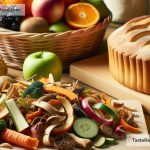Embrace the Blossom: Zero-Waste Baking with Edible Flowers
Baking is not just an activity. For many, it’s a form of expression, a way to love, and a method to bond. But as we whisk through flours and sugars, it’s also essential to consider our planet. That’s where zero-waste baking comes in, bringing with it an array of colors and flavors through something you may not have considered using in your kitchen – edible flowers!
Why Zero-Waste?
The zero-waste movement encourages us to use every part of the ingredients we have to minimize waste. This philosophy doesn’t mean you have to change everything overnight, but small steps can make a significant difference. And what’s more fun than incorporating something as beautiful as edible flowers into your baking?
The Blooming Good of Edible Flowers
Edible flowers aren’t just pretty decorations; they can add unique flavors and aromas to your baked goods. From the subtle sweetness of violets to the peppery punch of nasturtiums, flowers can transform a simple recipe into something extraordinary. Plus, using flowers (especially if you grow them yourself or source them locally) can be a step forward in creating a more sustainable kitchen.
Getting Started with Edible Flowers
First, it’s crucial to know which flowers are safe to eat. Common edible flowers include roses, calendulas, lavender, pansies, and marigolds. Always ensure that the flowers are free from pesticides and other chemicals. If you’re picking them from a garden, make sure they haven’t been treated with any harmful substances.
When using flowers in baking, there are endless possibilities. Here are some simple ideas to get you started on your zero-waste, flower-powered baking journey:
1. Flower-Infused Sugars
A simple way to start is by infusing sugar with flower petals. This not only gives the sugar a lovely hue but also subtly flavors it. Lavender or rose petals work beautifully. Just layer the petals and sugar in a jar, let it sit for a week, and then sift out the petals. Use this sugar in any baking recipe to add a floral twist.
2. Decorative Toppings
Fresh or candied edible flowers make for stunning, Instagram-worthy decorations on cakes and cupcakes. To candy flowers, brush them lightly with egg white (from pasteurized eggs to avoid any health risks), sprinkle with superfine sugar, and let them dry. They’ll look gorgeous atop your creations and add a delicate flavor.
3. Flavorful Batters and Doughs
Incorporating finely chopped flower petals or infused water (like rose or lavender water) into your batters and doughs can beautifully scent and flavor your baked goods. Imagine a lavender-infused lemon cake or rose petal shortbread cookies – simple, elegant, and delicious.
Sustainability in Practice
When baking with edible flowers, embrace the principles of zero waste by being mindful of how you source and use your ingredients. Here are some tips:
-
Grow Your Own: If space allows, growing your own edible flowers is both rewarding and sustainable. You’ll know exactly how they were grown, and they don’t get more local than your backyard or balcony.
-
Compost Scraps: Use the leftover parts of the flowers, like stems and leaves, in your compost bin if you have one. This returns nutrients to the soil and reduces waste.
-
Local and Seasonal: Source flowers from local farmers’ markets or edible flower suppliers. Choosing local helps reduce transportation emissions, and opting for seasonal varieties minimizes the environmental impact further.
Final Thoughts
Baking with edible flowers not only brings a new layer of flavor and beauty to your creations but also aligns with a more thoughtful and sustainable approach to cooking and eating. As you explore the colorful world of edible flowers, remember that every small choice in favor of sustainability helps our planet. So, why not let your baking make a difference? Embrace the blooming wonders of nature, and let’s bake the world a better place, one petal at a time.


